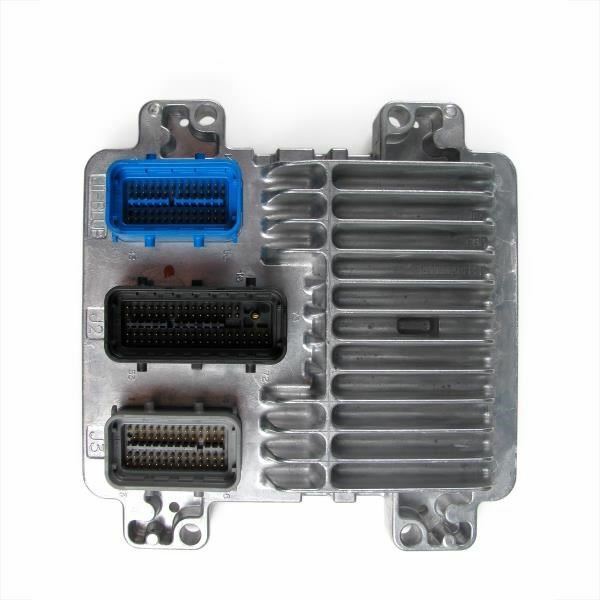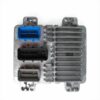The Brain of Your Engine: Restoring Power and Reliability
The Powertrain Control Module (PCM), often called the Engine Control Module (ECM), is the central command center for your 2006 Isuzu Ascender’s 4.2L engine. It meticulously manages critical functions like fuel delivery, ignition timing, transmission shifting, and emissions systems. When this vital component begins to fail, it can cause a cascade of frustrating and seemingly unrelated problems, from a simple check engine light to a vehicle that won’t start at all. This replacement PCM, part number 12604439, is the definitive solution to restore your vehicle’s original performance and efficiency.
Unlike a generic part from a local store, this module isn’t just a piece of hardware. It’s a complete solution, professionally programmed with the latest official GM software updates specifically for your vehicle’s Vehicle Identification Number (VIN). This critical programming step ensures that the module communicates flawlessly with all other systems in your Ascender, including the anti-theft system, transmission, and body control module. This eliminates the need for expensive dealership programming or specialized tools, making the repair process straightforward and cost-effective.
From the Diagnostic Bay
We had a 2006 Chevy Trailblazer (a sister vehicle to the Ascender with the same 4.2L engine) come into the shop with a maddeningly intermittent issue. The owner complained of random stalling at stoplights and occasional harsh shifts from 1st to 2nd gear. There were no consistent trouble codes, just a generic U-code for lost communication every now and then. We checked the fuel pressure, cleaned the throttle body, and inspected the wiring harnesses for an hour. Everything looked perfect. On a hunch, we monitored the live data from the PCM and noticed the ignition timing values would suddenly drop out for a split second, just before a stall. We swapped in one of our pre-programmed PCMs, and the problem vanished instantly. The internal processor on the old unit was failing under thermal stress, a common issue for these modules as they age. It’s a classic case where the root cause is the computer itself, not the sensors or mechanical parts it controls.
Is Your Isuzu Ascender Experiencing These Symptoms?
A failing PCM can manifest in various ways. If you’re noticing any of the issues below, a faulty control module is a likely culprit. Replacing your old unit with this pre-programmed module can resolve these common problems.
- ✔ Check Engine Light: An illuminated Check Engine Light (CEL) for various sensor or communication codes that keep returning.
- ✔ Poor Fuel Economy: A sudden and unexplained drop in your vehicle’s gas mileage.
- ✔ Rough Idling or Stalling: The engine runs erratically, idles poorly, or stalls unexpectedly at intersections.
- ✔ Failed Emissions Test: Inability to pass a smog check due to persistent trouble codes or system readiness monitor issues.
- ✔ No-Start Condition: The engine cranks but refuses to start, even with a good battery and fuel.
- ✔ Erratic Transmission Shifting: Harsh, delayed, or unpredictable gear changes.
- ✔ Loss of Power: The vehicle feels sluggish and lacks its usual acceleration.
The Importance of a VIN-Programmed 2006 Isuzu Ascender PCM
Your vehicle’s VIN is more than just a serial number; it’s a blueprint containing specific information about its engine, transmission, emissions equipment, and factory-installed options. Our process uses your VIN to load the exact software your vehicle needs. This ensures perfect compatibility and function, addressing Technical Service Bulletins (TSBs) and software improvements GM released after your vehicle left the factory. This is the key to a true plug-and-play installation. Simply provide your VIN after purchase, and we handle the complex part, so you can get back on the road with confidence.
This module is a direct replacement for a wide range of part numbers, ensuring broad compatibility across the GM GMT360 platform. It fits not only the 2006 Isuzu Ascender but also the Chevrolet Trailblazer, GMC Envoy, Buick Rainier, Hummer H3, Saab 9-7X, and other models listed in the fitment guide. By cross-referencing multiple part numbers, we guarantee you receive the correct, updated hardware and software for your specific application.
Frequently Asked Questions
What is the difference between a PCM, ECM, and ECU?
These acronyms are often used interchangeably. PCM (Powertrain Control Module) typically controls both the engine and transmission. ECM (Engine Control Module) and ECU (Engine Control Unit) usually refer to a module that only controls the engine. For your 2006 Isuzu Ascender, PCM is the most accurate term as it manages the entire powertrain.
Is this module difficult to install?
No, the physical installation is very straightforward. It is designed to be plug-and-play. You will need basic hand tools to disconnect the battery and unbolt the module. Since we program it to your VIN before shipping, you do not need any special computer equipment for the installation.
How do I provide my Vehicle Identification Number (VIN)?
After you complete your purchase, you will receive instructions on how to send us your 17-digit VIN. We cannot ship your part until we receive this information, as the programming is essential for the module to function in your vehicle.
Will I need to do anything after installing the new PCM?
In some cases, you may need to perform a simple security relearn procedure to sync the new PCM with your vehicle’s anti-theft system. This procedure typically involves cycling the ignition key and does not require any special tools. We can provide instructions for this process if needed.
Will this fix my check engine light?
If the check engine light is caused by a faulty PCM, then yes, this part will resolve the issue. However, it’s always best to have the codes professionally diagnosed to ensure the problem isn’t with a sensor or wiring. This PCM corrects issues stemming from the module itself.
Is this a used part?
This is a high-quality, tested, and verified replacement component. Each unit undergoes a rigorous inspection and programming process to ensure it meets or exceeds original equipment specifications for performance and reliability.


